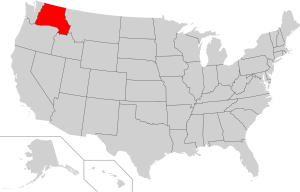Lincoln (proposed Northwestern state) facts for kids
Quick facts for kids
Lincoln
|
|
|---|---|
|
proposed U.S. state
|
|
| State of Lincoln | |
| Nickname(s):
Inland Empire; Inland Northwest
|
|

Location of Lincoln within the United States
|
|
| Country | United States |
| Before statehood | Eastern Washington & Idaho Panhandle |
| Admitted to the Union | (51st (hypothetical)) |
| Capital (and largest city) |
Spokane |
| Largest metro and urban areas | Spokane metropolitan area |
| Legislature | Lincoln State Legislature |
| • Upper house | Lincoln State Senate |
| • Lower house | Lincoln House of Representatives |
| U.S. House delegation | 3 Representatives (list) |
| Area | |
| • Total | 67,633 sq mi (175,246 km2) |
| Area rank | 20th (hypothetical) |
| Elevation | ? ft (? m) |
| Highest elevation
(Mount Adams (located on Washington—Lincoln border))
|
12,280 ft (3,743 m) |
| Lowest elevation | ~80 ft (~24 m) |
| Population | |
| • Total | 1,897,348 |
| • Rank | 37th (hypothetical) |
| • Density | 28.05/sq mi (10.83/km2) |
| • Density rank | 42nd (hypothetical) |
| Demonym(s) | Lincolnite |
| Language | |
| • Official language | N/A English (de facto) |
| Time zone | UTC-08:00 (Pacific) |
| • Summer (DST) | UTC-07:00 (PDT) |
| USPS abbreviation |
Postal is N/A
|
| Traditional abbreviation | Linc. |
The State of Lincoln is the name given to several ideas for creating a new state in the Northwest United States. These ideas usually involve combining parts of Idaho and Washington. The proposed state was named after Abraham Lincoln, who was president during the American Civil War. His name was also suggested for the states that eventually became North Dakota and Wyoming.
Contents
What is the Proposed State of Lincoln?
The idea for the State of Lincoln often includes the Panhandle of Idaho and Eastern Washington. This means the area east of the Cascade Mountains. Other names suggested for this new state were "Columbia" or "Eastern Washington."
The first time this idea came up was in 1865. This was when Idaho's capital moved from Lewiston to Boise. At that time, the Idaho Territory was much larger. It included almost all of present-day Montana and Wyoming.
In the 1860s, people in northern Idaho, especially around Lewiston, wanted a "Columbia Territory." This territory would have been made from parts of eastern Washington, northern Idaho, and western Montana.
In 1901, another proposal suggested combining the Idaho Panhandle with Eastern Washington to create the state of Lincoln. A third idea in the late 1920s included eastern Washington, northern Idaho, and western Montana. More recently, in 1996, 1999, and 2005, similar proposals came from Washington. Idaho also had a campaign for "North Idaho," with T-shirts saying "North Idaho – A State of Mind."
Areas That Might Be Included
North Idaho's Unique Situation
Just like Eastern and Western Washington often feel different, North Idaho also feels disconnected from its state capital in Boise. North Idaho usually means the ten northern counties of the state. These include Boundary, Bonner, Benewah, Clearwater, Idaho, Kootenai, Latah, Lewis, Nez Perce, and Shoshone.
The Salmon River separates these counties from Southern Idaho. Also, North Idaho uses Pacific Time, while the rest of Idaho uses Mountain Time. This time difference adds to the feeling of being separate.
There have also been ideas for a "State of Kootenai." This would combine the six northernmost counties of Idaho with the six westernmost counties of Montana. This new state would have about 524,888 people.
Eastern Washington and Eastern Oregon
Some ideas for a "State of Lincoln" have also included eastern Oregon. People in Eastern Oregon often feel the same way about Portland as Eastern Washingtonians feel about Seattle. They feel disconnected from the politics and culture of the western parts of their states.
If Eastern Washington and Eastern Oregon combined, it would create one of the largest states by area in the country. It would stretch from the eastern side of the Cascade Mountains to the Idaho border.
Why a New State?
The state legislatures of Idaho and Washington have seen bills proposing that parts of their states break away. Idaho did not agree to these ideas because the Panhandle area brought in more tax money per person than the southern part of the state.
The Inland Northwest region is roughly the area that would make up the State of Lincoln. The largest city in this proposed state would be Spokane. Spokane is currently Washington's second-largest city. The greater Spokane area is the third-largest population center in the Northwest, after Seattle and Portland.
In 1907, a proposal in Spokane suggested a new state named "Lincoln." This state would be made from eastern Washington, northeastern Oregon, and northern Idaho.
Other States Almost Named Lincoln
North Dakota
In the 1880s, when the Dakota Territory was becoming a state, there was a plan to split it into northern and southern halves. Some politicians suggested naming the northern half "Lincoln." However, people living in the territory did not like this idea. In 1889, the territory became two states: North Dakota and South Dakota.
Wyoming
When the idea for Wyoming Territory was first discussed in 1868, some people in the U.S. Senate wanted to name it Lincoln Territory. They wanted to honor the assassinated president, Abraham Lincoln. However, many senators did not like naming a territory after just one person. They preferred names that came from local areas or Native American languages. The name "Wyoming" came from a Lenape Indian word meaning "large plains." This name was kept when Wyoming became a state in 1890.
See also
 In Spanish: Estado de Lincoln (noreste) para niños
In Spanish: Estado de Lincoln (noreste) para niños

